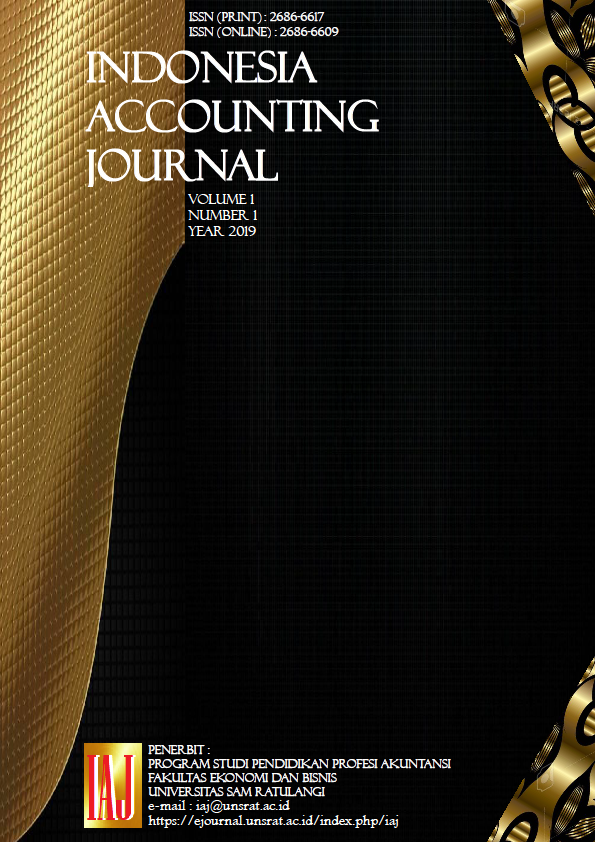Does maturity signals high risk and high return?
DOI:
https://doi.org/10.32400/iaj.25404Keywords:
signaling, maturity, risk, return, IndonesiaAbstract
The objective of this study is to examine the interaction between firm maturity and firm growth opportunities over risk and its impact on returns. This study uses 135 firms listed in Indonesia Stock Exchange during 2010 to 2016 as sample which gives 945 as total observed data. This study conducts path analysis in term for hypothesis testing and finds that firm maturity has significant role to increase the risk which gives impact on increasing the returns. In context of Indonesian firms, the findings imply that mature firms will have higher risk and higher returns.
References
Asquith, P., & Mullins, D. W. (1986). Signalling with dividends, stock repurchases, and equity issues. Financial Management, 15(3), 27-44. http://www.jstor.org/stable/3664842
Ben-Horim, M., & Levy, H. (1980). Total risk, diversifiable risk and nondiversifiable risk: A pedagogic note. The Journal of Financial and Quantitative Analysis, 15(2), 289-297. https://doi.org/10.2307/2330346
Bernardo, A. E., Chowdhry, B., & Goyal, A. (2007). Growth options, beta, and the cost of capital. Financial Management, 36(2), 1-13. https://doi.org/10.1111/j.1755-053X.2007.tb00084.x
Bollerslev, T., & Zhang, B. Y. B. (2003). Measuring and modeling systematic risk in factor pricing models using high-frequency data. Journal of Empirical Finance, 10, 533-558. https://doi.org/10.1016/S0927-5398(03)00004-5
Budiarso, N. S., Subroto, B., T, Sutrisno., & Pontoh, W. (2019). Dividend catering, life-cycle, and policy: Evidence from Indonesia. Cogent Economics & Finance, 7(1). https://doi.org/10.1080/23322039.2019.1594505
Connelly, B. L., Certo, S. T., Ireland, R. D., & Reutzel, C. R. (2011). Signaling theory: A review and assessment. Journal of Management, 37(1), 39–67. https://doi.org/10.1177/0149206310388419
DeAngelo, H., DeAngelo, L., & Stulz, R. M. (2006). Dividend policy and the earned/contributed capital mix: a test of the life-cycle theory. Journal of Financial Economics, 81(2), 227–254. https://doi.org/10.1016/j.jfineco.2005.07.005
Easterbrook, F. H. (1984). Two agency-cost explanations of dividends. The American Economic Review, 74(4), 650-659. http://www.jstor.org/stable/1805130
Fairchild, R., Guney, Y., & Thanatawee, Y. (2014). Corporate dividend policy in Thailand : Theory and evidence. International Review of Financial Analysis, 31, 129-151. https://doi.org/10.1016/j.irfa.2013.10.006
Fama, E. F., & French, K. R. (1992). The crossâ€section of expected stock returns. The Journal of Finance, 47(2), 427-465. https://doi.org/10.2307/2329112
Fama, E. F., & French, K. R. (1993). Common risk factors in the returns on stocks and bonds. Journal of Financial Economics, 33(1), 3-56. https://doi.org/10.1016/0304-405X(93)90023-5
Fama E. F., & French K. R. (2001). Disappearing dividends: changing firm characteristics or lower propensity to pay? Journal of Financial Economics, 60(1), 3–43. https://doi.org/10.1016/S0304-405X(01)00038-1
Frazzini, A., & Pedersen, L. H. (2014). Betting against beta. Journal of Financial Economics 111(1), 1-25. http://dx.doi.org/10.1016/j.jfineco.2013.10.005
Grullon, G., Michaely, R., & Swaminathan, B. (2002). Are Dividend Changes a Sign of Firm Maturity? The Journal of Business, 75(3), 387-424. http://doi.org/10.1086/339889
Gulec, O. F., & Karacaer, S. (2017). Corporate life cycle methods in emerging markets: Evidence from Turkey. Journal of Economics, Finance and Accounting, 4(3), 224-236. http://doi.org/10.17261/Pressacademia.2017.690
Lakonishok, J., & Shapiro, A. C. (1986). Systematic risk, total risk and size as determinants of stock market returns. Journal of Banking and Finance, 10(1), 115–132. https://doi.org/10.1016/0378-4266(86)90023-3
Lewis, C. M., Rogalski, R. J., & Seward, J. K. (2003). Industry conditions, growth opportunities and market reactions to convertible debt financing decisions. Journal of Banking and Finance, 27(1), 153–181. https://doi.org/10.1016/S0378-4266(01)00212-6
R.A., D., & Rahmanti, W. (2013). Return dan risiko saham pada perusahaan perata laba dan bukan perata laba. Jurnal Dinamika Akuntansi, 5(1). https://doi.org/10.15294/jda.v5i1.2563
Ross, S. (1977). The Determination of financial structure: The incentive-signalling approach. The Bell Journal of Economics, 8(1), 23-40. https://doi.org/10.2307/3003485
Teh, K., & Lau, W. (2017). The dual-beta model: Evidence from the Malaysian Stock Market. Indonesian Capital Market Review, 9(1), 39-52. https://doi.org/10.21002/icmr.v9i1.6367
Weitzman, M. L. (2013). Tail-hedge discounting and the social cost of carbon. Journal of Economic Literature, 51(3), 873-882. http://dx.doi.org/10.1257/jel.51.3.873
Downloads
Additional Files
Published
Issue
Section
License
The articles published in Indonesia Accounting Journal are licensed under Creative Commons Attribution 4.0 International License with authors as copyright holders.
Â

This work is licensed under a Creative Commons Attribution 4.0 International License.
Â
Under this license then authors free to:
- Share — copy and redistribute the material in any medium or format.
- Adapt — remix, transform, and build upon the material for any purpose, even commercially.
Under the following terms :
- Attribution — You must give appropriate credit, provide a link to the license, and indicate if changes were made. You may do so in any reasonable manner, but not in any way that suggests the licensor endorses you or your use.
- No additional restrictions — You may not apply legal terms or technological measures that legally restrict others from doing anything the license permits.
Notices:
- You do not have to comply with the license for elements of the material in the public domain or where your use is permitted by an applicable exception or limitation.
- No warranties are given. The license may not give you all of the permissions necessary for your intended use. For example, other rights such as publicity, privacy, or moral rights may limit how you use the material.


